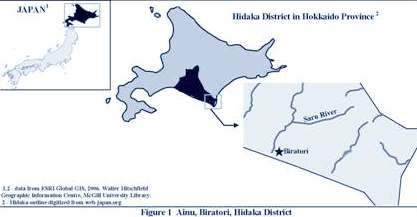BIRATORI TOWN, AINU, SARU RIVER REGION, JAPAN
Community Food System Data Tables
Introduction
 This field study was carried out in Biratori, a town in the Hidaka District, located in the Southern part of Hokkaido. The aim was to provide research to preserve the Ainu traditional food culture. Biratori stretches over an area 743 16km2 and is divided into 17 districts. The research was conducted in Nibutani, Osachinai, Shiunkotsu, Nukibetsu and Toyonuka communities of Biratori town because of high concentration of Ainu population in these areas (Figure 1).
This field study was carried out in Biratori, a town in the Hidaka District, located in the Southern part of Hokkaido. The aim was to provide research to preserve the Ainu traditional food culture. Biratori stretches over an area 743 16km2 and is divided into 17 districts. The research was conducted in Nibutani, Osachinai, Shiunkotsu, Nukibetsu and Toyonuka communities of Biratori town because of high concentration of Ainu population in these areas (Figure 1).
Download pdf image of Ainu map
The Ainu are believed to have settled in the area around 1000 AD. The Japanese migrated to Hokkaido from the main island in 1400 and contact between the Ainu and Japanese became more frequent. After the Shakushain War, the Ainu lost power over the area and became under Japanese control. Many efforts were made to assimilate the Ainu into mainstream society which resulted in decline of traditional cultural practices. The Biratori Ainu Cultural Preservation Group (BACPG) was founded in 1998 in efforts to gather information and preserve Ainu traditions and knowledge.
This study aimed to improve the socio-cultural environment for the Ainu people through promoting understanding of Ainu traditional foods, revitalizing the use of them, and eventually contributing to emotional and physical health.
The study team was comprised of the following:
- Biratori Ainu Culture Preservation Group (BACPG)
- Taichi Kaizawa, Ainu Culture Research Centre
- Koichi Kaizawa, Ainu Community Leader
- Miwako Kaizawa, Ainu food specialist
- Dr Hidetomo Iwano, Food Composition Analyst
- Dr Satomi Ishii, Nutritionist
Center for Indigenous Peoples’ Nutrition and Environment (CINE), McGill University
- Dr Harriet Kuhnlein (Professor)
Notes on food data tables
The examination of Ainu traditional food began in March 2004 by conducting key informant interviews, collecting basic archival material and food samples for composition analysis. In this process, 15 traditional Ainu foods were identified which community members would like to preserve for their younger generation
Notes on food groups
Users should know that the data presented here do not represent absolute values. The purpose of this publication is to present a true reflection of the usual composition of foods as available and/or consumed among Ainu community members. This is a living document and nutrient information will be added and/or updated when available. These 15 foods are divided into three food groups:
Nutrient analyses of some of these foods were carried out in the food laboratory of Rakuno Gakuen University, Ebetsu, Japan. For others, nutrient information was sourced from Japan Standard Food Composition Chart (2000) and report of Health Promotion Project, 1996.
Where possible, the Scientific and English names, harvest period, seasonality of use and preparation of these foods are also documented.
Notes on food components
There are approximately 20 to 26 components in the main body of the tables, which are presented in a fixed format for each record. The order of presentation is based on major nutrients categories. Vitamin A values are reported in both Vitamin A retinol equivalents (RE-µg) and in retinol activity equivalents (RAE-µg). These values are calculated and reported for only those foods for which beta carotene and total carotenes values are available. Vitamin A RAE values are reported to make them merely compatible with the DRI (Dietary Reference Intake) recommendation.
References
- Composition analysis was completed in 2005 at Rakuno Gakuen University, Ebetsu, Japan.
- http://www.mext.go.jp/english/news/2000/11/001150.htm
- Report of Health Promotion Project Using Ainu Plants, 1996.